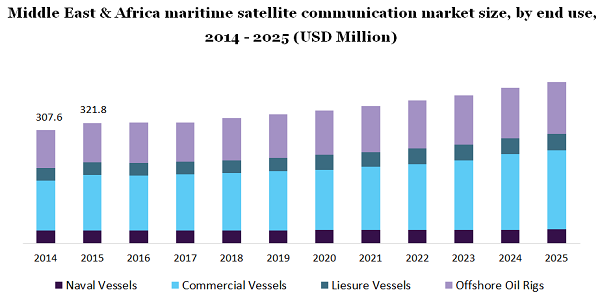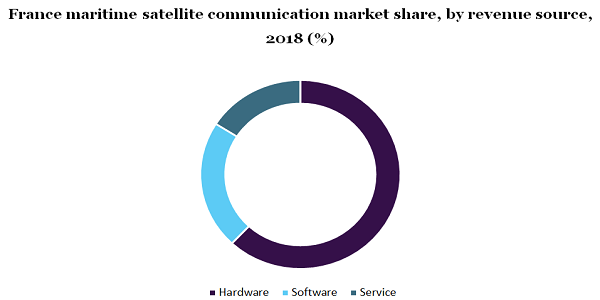- US: +1-408-610-2300
- Toll Free: +1-866-831-4085
- Become a Client
The global maritime satellite communication market size was worth USD 2.64 billion in 2018. The market is predicted to register an 8.9% CAGR over the forecast duration, 2019 to 2025. The increasing need for cost-effective and reliable communication services at sea is driving the market growth. In addition, increasing demand for network systems for navigational purposes is further bolstering the market growth. Considering the growing demand, maritime communication players such as Inmarsat Global Limited and Iridium Communications are investing a significant amount to provide an affordable solution.
Maritime telecommunication components have become mandatory for short and long voyaging operations. Be it commercial fishing, recreational yacht, or normal maritime operation, effective communication has become indispensable. Cellular services are available only offshore of the sea and they have a very limited range.

Earlier, satellite networks have been used for ship-to-shore communication along with other marine vessels. In addition, satellite communication has changed now from voice calls to various other services such as entertainment, monitoring services, and tracking. Owing to their varied applications, these components have become widespread.
In marine vessels, various equipment such as antenna, transmitter/transponder, satellite phone, modem/router, and receiver is used. These components are also used in meteorological monitoring and navigation. Technical advancements in the field of marine engineering have resulted in the design of smaller antennas and increased data transfer rates.
Marine satellite equipment that is used for defense by naval forces helps in receiving and making distress calls and areal monitoring. In addition, increasing investment to replace the existing conventional system is anticipated to propel market growth. To counter different adverse challenges, defense forces require a robust communication system with zero to the minimum time lag.
Among different types, the Very Small Aperture Terminal (VSAT) category accounted for the largest share in the maritime satellite communication market. This system offers benefits over Mobile Satellite Services (MSS). These benefits include global coverage and minimum time lag. Further, VSAT offers continuous internet access that can be used for sharing files, email, and instant messaging. Moreover, these systems offer an option for unlimited data usage at a fixed monthly rate.
Despite the advancement in marine operations, MSS is estimated to hold its place where the use of data is minimum. For example, fishing boats are projected to adopt VSAT slowly while rapidly opting for MSS. In addition, the MSS-L band offers connectivity even in extreme environmental conditions and can be used as a backup. Moreover, L-band is reliable and can outperform VSAT in challenging weather conditions.
Depending on the end-use, the commercial vessel category dominated the market with a value of over 1.3 billion in 2018. Increasing trade activities in countries such as India, China, and Brazil is driving the segment growth. The shipping industry alone is responsible for nearly 90% of trade worldwide. Moreover, maritime trade offers competitive costs thereby, benefitting consumers across the globe. With increasing global trade, there has been a rise in the number of marine fleets and vessels which, in turn, positively driving the market.
The Asia Pacific is witnessing a rise in marine trade, primarily because of the evolution of China as a new manufacturing hub and favorable trade policies in the region. Globally, maritime trade increased by 4% in 2017. In addition, it is predicted to grow significantly shortly. As estimated by UNCTAD, the year-on-year growth would be 3.8% till the year 2023.
In 2018, the hardware segment dominated the maritime satellite communication market with more than 30% share by revenue. Further, the segment is predicted to continue its domination over the forecast duration. Hardware components have high costs and they are used in a large amount. High cost attributes to the significant revenue of this segment. In addition, increasing deployment of VSAT broadband in both new and existing fleets is anticipated to offer lucrative growth opportunities.

It is predicted that the software category would register moderate growth over the next six years. Increasing the use of application-based software is driving the segment demand. For example, different software is used for various applications such as Doppler correction, entertainment, navigational, tracking, and prediction. Further, the growing adoption of marine satellite components in luxury yachts, cruise ships, and defense vessels are is estimated to supplement the market growth.
It is expected that Asia Pacific would emerge as the leading region over the forecast duration because of rising VSAT adoption in cruise and merchant ships. Factors such as increasing modernization of the existing system, advancement in naval defense, and rise in the number of naval disputes are propelling the APAC market growth. China, India, and Japan are among the major consumers in the region attributing to the maximum share.
On the other hand, in terms of growth, Europe is expected to occupy the second position in the market. The rising number of luxury vessels is the prime factor driving regional growth. The rise in the number of luxury vessels is driven by the growing demand for the tourism industry and individual procurement from high-net-worth individuals. Europe is estimated to witness a surge in coastal tourism in the next few years. The growing popularity of activities such as kayaking, boating adventures, fishing, and snorkeling are driving coastal tourism in the region.
The COVID-19 outbreak has negatively affected the market growth. Maritime trade accounts for nearly 90% of the trade activities globally. Owing to the lockdown imposed in the different parts of the world, the supply chain was greatly disrupted. This disruption continued as several countries debarred trade with China with immediate effect. In addition, the demand for several consumer goods witnessed a sudden decline as the pandemic has reduced consumer purchasing power and slowed down the global economy.
Key players in the market are ViaSat Inc., KVH Industries, Inc., EchoStar Corporation, Saab AB, Schwarz GMBH, Leonardo S.p.A and Inmarsat Global Limited among others. These players are focusing on undertaking various initiatives such as merger & acquisition, new product launch, competitive pricing, and partnerships to strengthen their position in the market.
For example, UAE-based Al Yah Satellite Communication Company PJSC acquired a mobile satellite company named Thuraya Telecommunications to expand its consumer base. Similarly, Singapore Technologies Engineering, in 2019 acquired Newtec Group.
|
Report Attribute |
Details |
|
The market size value in 2020 |
USD 3.0 billion |
|
The revenue forecast in 2025 |
USD 4.7 billion |
|
Growth Rate |
CAGR of 8.9% from 2019 to 2025 |
|
The base year for estimation |
2018 |
|
Historical Data |
2014 - 2017 |
|
Forecast period |
2019 - 2025 |
|
Quantitative units |
Revenue in USD billion and CAGR from 2019 to 2025 |
|
Report coverage |
Revenue forecast, company ranking, competitive landscape, growth factors, and trends |
|
Segments covered |
Type, revenue source, end-use, and region. |
|
Regional scope |
North America; Europe; Asia Pacific; Latin America; MEA |
|
Country scope |
U.S.; Canada; U.K.; Germany; France; China; Japan; India; Mexico; Brazil |
|
Key companies profiled |
Inmarsat Global Limited; Iridium Communications Inc.; Leonardo S.p.A.; Thuraya Telecommunications Company; ViaSat Inc.; Orbcomm Inc.; KVH Industries, Inc.; Singapore Technologies Engineering Ltd; EchoStar Corporation; Kongsberg Maritime AS; Saab AB; and Rohde & Schwarz GMBH. |
|
Customization scope |
Free report customization (equivalent to up to 8 analysts’ working days) with purchase. Addition or alteration to country, regional & segment scope. |
|
Pricing and purchase options |
Avail of customized purchase options to meet your exact research needs. |
This report forecasts revenue growth at global, regional, and country levels, and provides an analysis of the latest industry trends in each of the sub-segments from 2014 to 2025. For this study, Million Insights has segmented the global maritime satellite communication market report based on type, revenue source, end-use, and region:
• Type Outlook (Revenue, USD Billion, 2014 - 2025)
• Very Small Aperture Terminal (VSAT)
• Ka-Band
• C-Band
• Others
• Mobile Satellite Services (MSS)
• Revenue Source Outlook (Revenue, USD Billion, 2014 - 2025)
• Hardware
• Software
• Services
• End-Use Outlook (Revenue, USD Billion, 2014 - 2025)
• Naval Vessel
• Commercial Vessels
• Leisure Vessels
• Offshore Oil Rigs
• Regional Outlook (Revenue, USD Billion, 2014 - 2025)
• North America
• The U.S.
• Canada
• Europe
• The U.K.
• Germany
• France
• the Asia Pacific
• China
• India
• Japan
• Latin America
• Brazil
• Mexico
• Middle East & Africa


Research Support Specialist, USA